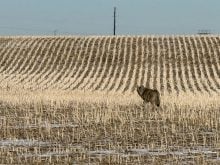HALIFAX – Now, says Nova Scotia agriculture minister Ernie Fage, the
hard work starts in the journey to craft a new long-term national farm
policy.
As co-chair of the June 27-28 federal-provincial agriculture ministers’
meeting that included the launch by Ottawa and seven provinces of the
legal text of the “agriculture and agri-food policy for the 21st
century,” Fage said the details of implementation agreements between
Ottawa and each province on program design will put meat on the bones
Read Also

More Canadian companies at Agritechnica 2025
A record number of Canadian agriculture machinery and tech companies are at Agritechnica 2025, with exporters being more aggresive looking for new markets.
of the principles document. Prince Edward Island is expected to sign up
later.
“Now it’s down to the nuts and bolts,” he told reporters June 28 at the
end of the conference. “Who gets it and how do you get it to them?”
Those detailed discussions and “implementation agreements” to be signed
over the next six to eight months will give farmers some answers to
questions about what’s in it for them.
Still, the 50-page agreement gives negotiators some precise direction.
It instructs, for example, that expanded crop insurance options be
available for producers no later than the 2005 crop year. The program
will be renamed “production insurance programs” and offer coverage for
an expanded range of production, including livestock, as well as a
“whole farm” insurance package.
Meanwhile, an enriched Net Income Stabilization Account program is to
be available to producers by April 1, 2003. Details are to be worked
out but the principles agreement says the new program will offer more
income stabilization and disaster mitigation protection and some way to
make the NISA program useful to beginning farmers who lack excess cash
to invest.
Alberta minister Shirley McClellan said she liked the talk of NISA
improvement so much she might even recommend that Alberta get back into
the program it left several years ago in frustration over its
weaknesses.
The signing ministers also agreed that by 2005, they will offer
“business interruption” insurance coverage to farmers.
And they promised to review the entire agreement in 2006, a year before
it expires, “with a view to improving it for further implementation
periods.”
The agreement sets standards against which environmental, food safety
and “renewal” results will be judged.
It requires an annual “report to citizens on progress made.”
It calls for assessment and realignment of public spending on research
and innovation by next year to make sure the goals of the agreement in
food safety, environment and renewal are being supported.
And while noting that the agreement says changes will be built from
existing programs, Canadian Federation of Agriculture president Bob
Friesen said he is confident that it also is flexible enough to allow
creation of new programs if existing programs are found wanting.
He said there is a general recognition that the Canadian Farm Income
Program has not worked well for grains and oilseeds producers because
it is slow in payment and based on historic low incomes.
“I think there is an onus on farm groups to design programs that work
better and then sell them to governments,” he said. “I think this
agreement is flexible enough to allow that.”














